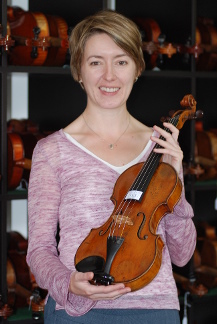TARISIO AUCTIONS |
 |
TARISIO AUCTIONS |
 |
Buying an instrument is a major decision for any player. Buying it at auction can add another layer of pressure � it's hard to keep your cool when you're in a crowded saleroom bidding against savvy dealers and the price is approaching your budget. Consider instead an internet auction, where you can bid anonymously from your own computer and take time to reflect before placing your bids.
This is what Tarisio Auctions offers. An American company launched by Dmitry Gindin, Jason Price, and Christopher Reuning in 1999, it specialises purely in online sales of stringed instruments and bows. It entered a market dominated by long-established auction houses, but Gindin and Reuning are both established experts and the three believed that the combination of their expertise and the flexibility of online bidding could be a winning formula. Eight years on, Tarisio (it's named after the 19th-century Italian dealer Luigi Tarisio, who sold the 'Messiah' Strad to Vuillaume) is one of the world's leading musical instrument auctioneers, running five sales a year from offices in New York and London.
The range of Tarisio's stock is wide � from items worth a few hundred dollars to Italian masterpieces by the likes of Stradivari, Guarneri and Amati. Perhaps the company's finest hour was its sale of Isaac Stern's collection in 2003, which saw record prices reached for many items. It also made headlines earlier this year when it sold a Tourte cello bow with an unbroken provenance for over £100,000 � a world record for a bow sold at auction.
So what happens in a typical Tarisio sale? On the whole, the process is much the same as that of a traditional auction house. For example, buyers have the same opportunity to try out lots before each auction, with public viewings held in New York and Boston for the US sales and in London for the European ones. If you're unable to attend the public viewings, it's also possible to make an appointment to try out specific items in the New York or London offices.
A printed catalogue is published for each sale, and Tarisio also makes its entire catalogue available for browsing online. This includes high-quality images of each item, which can be enlarged to well over 100%. Like other auction houses, Tarisio catalogues some items as 'attributed to', 'possibly by' and so on. It is always worth seeking a second opinion for any lot, but Tarisio does guarantee items catalogued as 'by' a particular maker within a set time period after an auction. This means that if you find that another expert disagrees with the Tarisio attribution, you have a chance to reclaim your money.
Each lot has an estimate and will normally also have a reserve price, below which it will not sell. This reserve is either lower than or equal to the low estimate. Always check the condition of items that interest you, especially if the estimate seems low. Tarisio will supply condition reports on request, but again, if you're no expert it's advisable to get a second opinion from a specialist. It's also a good idea to check the prices of similar items sold at previous auctions. Tarisio's website features the Red Book of auction results, which allows you to compare the prices of items by a particular maker sold by the major auction houses over the past 20 years.
The sales themselves last around two weeks. To bid, you first need to register online and choose a bidder name that ensures your anonymity; you then receive a password, which allows you to place bids. Bidding is by set increments, as at a live auction, and you can see when the reserve price has been met. If you don't have the time or inclination to bid yourself, it's possible to leave a proxy bid � the maximum that you're willing to pay. The system will then bid for you, either until you have won the lot or your maximum price has been reached. You'll receive an email confirmation each time a bid is placed.
Each lot has a separate ending time, allowing you to bid for more than one item in any sale, and this is extended by 15 minutes if bids are still being placed ten minutes before the deadline. This enables you to continue bidding until you have placed your highest bid. If you are the high bidder and 'win' your lot, you have seven days to pay for it and can then either pick it up yourself, or have it shipped to you.
If you do decide to take the plunge and bid for an instrument or bow it's wise to do your homework first, but as Tarisio's Jason Price says, 'It just may well be the perfect way to find the instrument of your dreams at an affordable price.' Tarisio's catalogue is available online at www.tarisio.com.
Naomi Sadler was formerly editor of 'The Strad' magazine and now runs Tarisio's London office.

| Direct correspondence to the appropriate ICS
Staff Webmaster: Eric Hoffman Director: John Michel Copyright © 1995- Internet Cello Society |
|---|